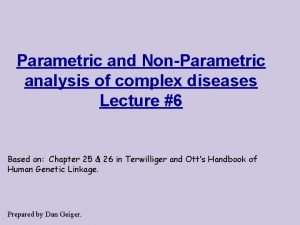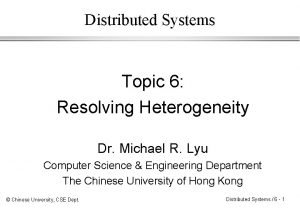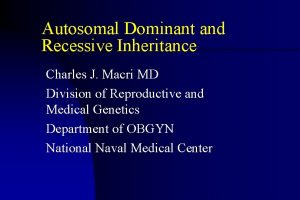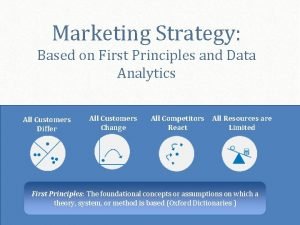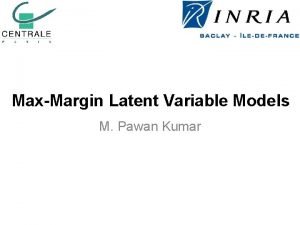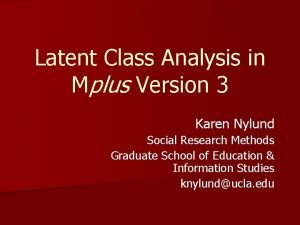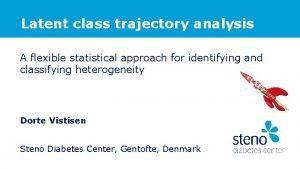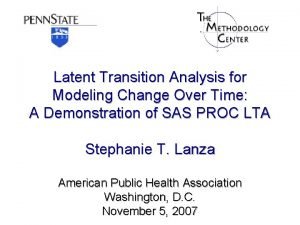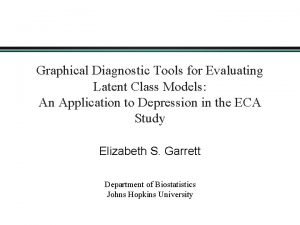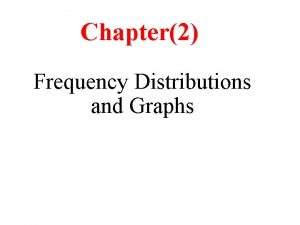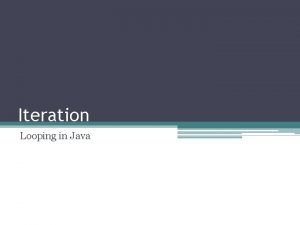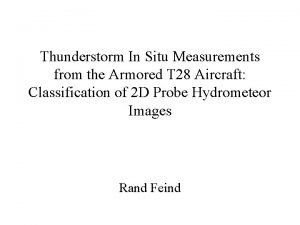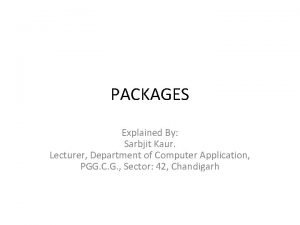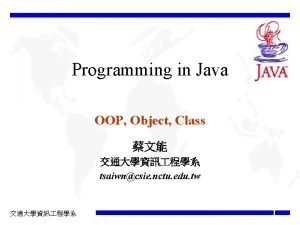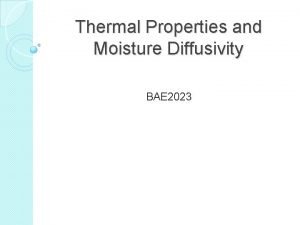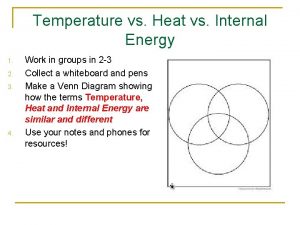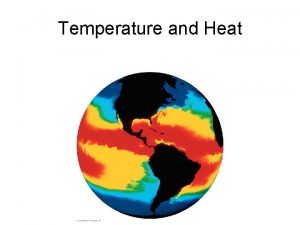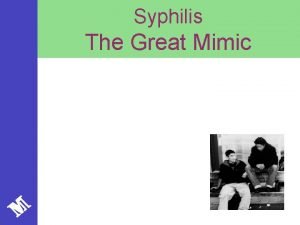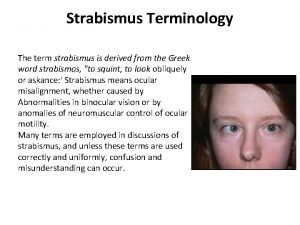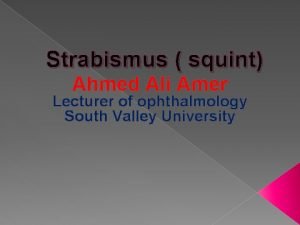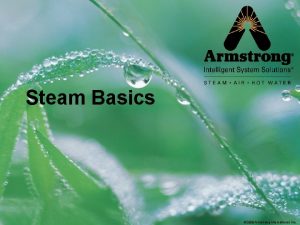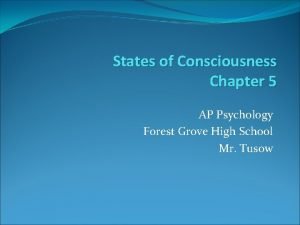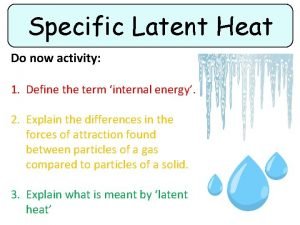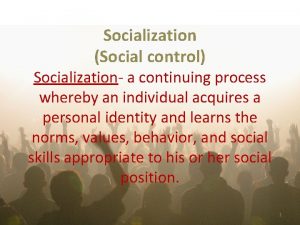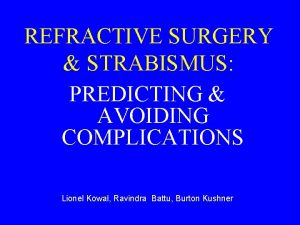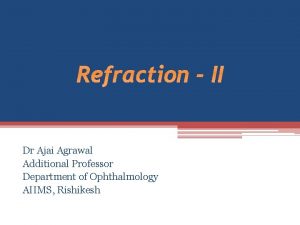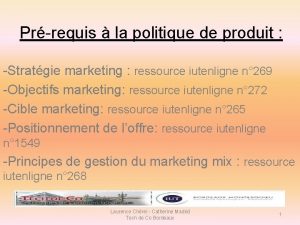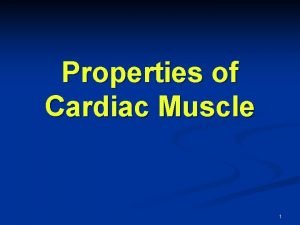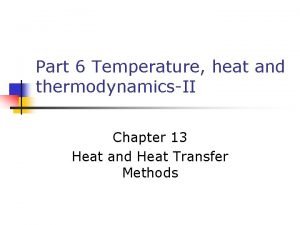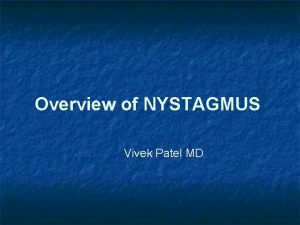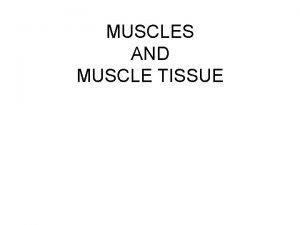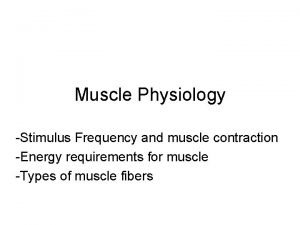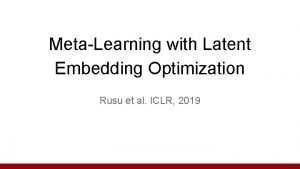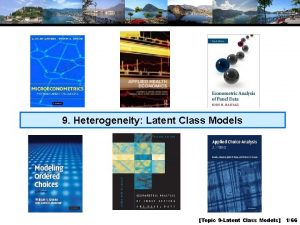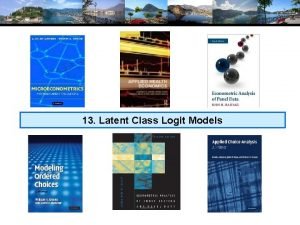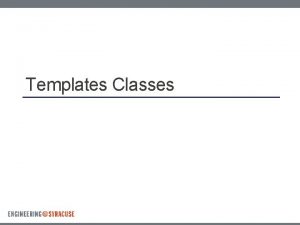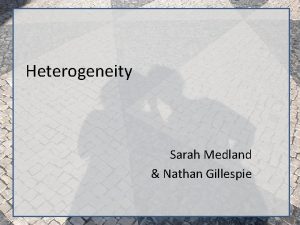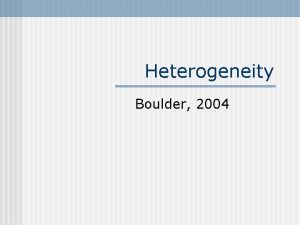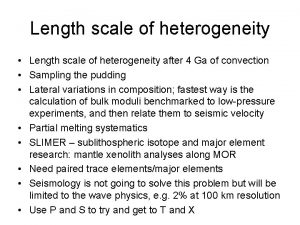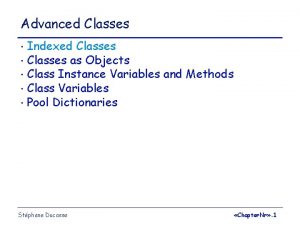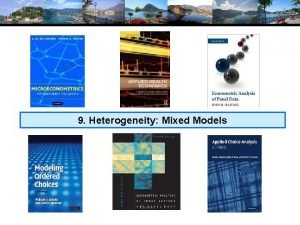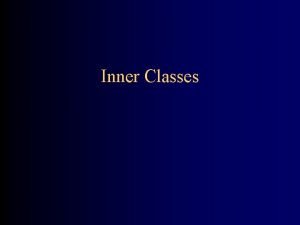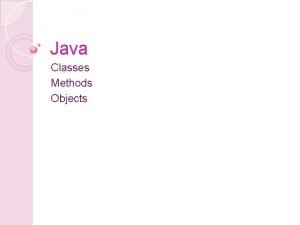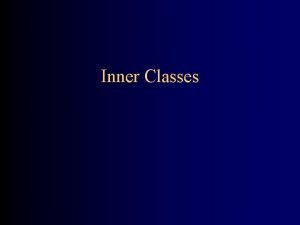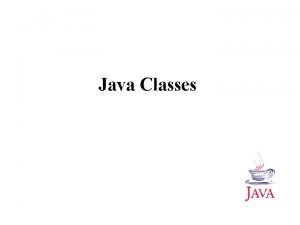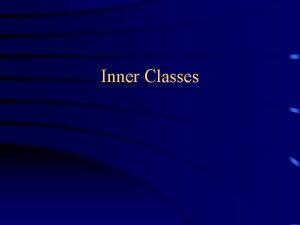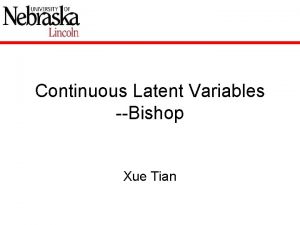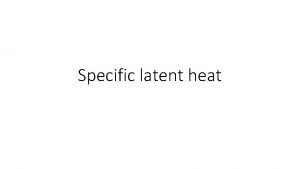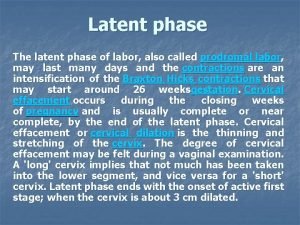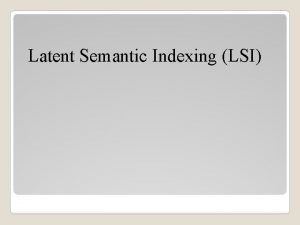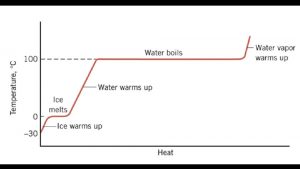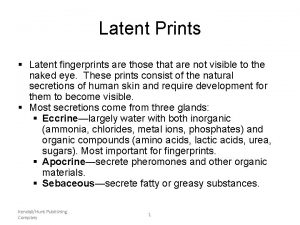8 Heterogeneity Latent Class Models Latent Classes A


































































- Slides: 66

8. Heterogeneity: Latent Class Models


Latent Classes • • A population contains a mixture of individuals of different types (classes) Common form of the data generating mechanism within the classes Observed outcome y is governed by the common process F(y|x, j ) Classes are distinguished by the parameters, j.

How Finite Mixture Models Work Density? Note significant mass below zero. Not a gamma or lognormal or any other familiar density.

Find the ‘Best’ Fitting Mixture of Two Normal Densities

Mixing probabilities. 715 and. 285

Approximation Actual Distribution

A Practical Distinction • Finite Mixture (Discrete Mixture): • • • Functional form strategy Component densities have no meaning Mixing probabilities have no meaning There is no question of “class membership” The number of classes is uninteresting – enough to get a good fit Latent Class: • • • Mixture of subpopulations Component densities are believed to be definable “groups” (Low Users and High Users in Bago d’Uva and Jones application) The classification problem is interesting – who is in which class? Posterior probabilities, P(class|y, x) have meaning Question of the number of classes has content in the context of the analysis

The Latent Class Model

Log Likelihood for an LC Model

Estimating Which Class

Posterior for Normal Mixture

Estimated Posterior Probabilities

More Difficult When the Populations are Close Together

The Technique Still Works -----------------------------------Latent Class / Panel Linear. Rg Model Dependent variable YLC Sample is 1 pds and 1000 individuals LINEAR regression model Model fit with 2 latent classes. ----+------------------------------Variable| Coefficient Standard Error b/St. Er. P[|Z|>z] Mean of X ----+------------------------------|Model parameters for latent class 1 Constant| 2. 93611***. 15813 18. 568. 0000 Sigma| 1. 00326***. 07370 13. 613. 0000 |Model parameters for latent class 2 Constant|. 90156***. 28767 3. 134. 0017 Sigma|. 86951***. 10808 8. 045. 0000 |Estimated prior probabilities for class membership Class 1 Pr|. 73447***. 09076 8. 092. 0000 Class 2 Pr|. 26553***. 09076 2. 926. 0034 ----+-------------------------------

‘Estimating’ βi

How Many Classes?

LCM for Health Status • • • Self Assessed Health Status = 0, 1, …, 10 Recoded: Healthy = HSAT > 6 Using only groups observed T=7 times; N=887 Prob = (Age, Educ, Income, Married, Kids) 2, 3 classes

Too Many Classes

Two Class Model -----------------------------------Latent Class / Panel Probit Model Dependent variable HEALTHY Unbalanced panel has 887 individuals PROBIT (normal) probability model Model fit with 2 latent classes. ----+------------------------------Variable| Coefficient Standard Error b/St. Er. P[|Z|>z] Mean of X ----+------------------------------|Model parameters for latent class 1 Constant|. 61652**. 28620 2. 154. 0312 AGE| -. 02466***. 00401 -6. 143. 0000 44. 3352 EDUC|. 11759***. 01852 6. 351. 0000 10. 9409 HHNINC|. 10713. 20447. 524. 6003. 34930 MARRIED|. 11705. 09574 1. 223. 2215. 84539 HHKIDS|. 04421. 07017. 630. 5287. 45482 |Model parameters for latent class 2 Constant|. 18988. 31890. 595. 5516 AGE| -. 03120***. 00464 -6. 719. 0000 44. 3352 EDUC|. 02122. 01934 1. 097. 2726 10. 9409 HHNINC|. 61039***. 19688 3. 100. 0019. 34930 MARRIED|. 06201. 10035. 618. 5367. 84539 HHKIDS|. 19465**. 07936 2. 453. 0142. 45482 |Estimated prior probabilities for class membership Class 1 Pr|. 56604***. 02487 22. 763. 0000 Class 2 Pr|. 43396***. 02487 17. 452. 0000

Partial Effects in LC Model -----------------------------------Partial derivatives of expected val. with respect to the vector of characteristics. They are computed at the means of the Xs. Conditional Mean at Sample Point. 6116 Scale Factor for Marginal Effects. 3832 B for latent class model is a wghted avrg. ----+------------------------------Variable| Coefficient Standard Error b/St. Er. P[|Z|>z] Elasticity ----+------------------------------|Two class latent class model AGE| -. 01054***. 00134 -7. 860. 0000 -. 76377 EDUC|. 02904***. 00589 4. 932. 0000. 51939 HHNINC|. 12475**. 05598 2. 228. 0259. 07124 MARRIED|. 03570. 02991 1. 194. 2326. 04934 HHKIDS|. 04196**. 02075 2. 022. 0432. 03120 ----+------------------------------|Pooled Probit Model AGE| -. 00846***. 00081 -10. 429. 0000 -. 63399 EDUC|. 03219***. 00336 9. 594. 0000. 59568 HHNINC|. 16699***. 04253 3. 927. 0001. 09865 |Marginal effect for dummy variable is P|1 - P|0. MARRIED|. 02414. 01877 1. 286. 1986. 03451 |Marginal effect for dummy variable is P|1 - P|0. HHKIDS|. 06754***. 01483 4. 555. 0000. 05195 ----+-------------------------------

Conditional Means of Parameters

An Extended Latent Class Model


Health Satisfaction Model -----------------------------------Latent Class / Panel Probit Model Used mean AGE and FEMALE Dependent variable HEALTHY in class probability model Log likelihood function -3465. 98697 ----+------------------------------Variable| Coefficient Standard Error b/St. Er. P[|Z|>z] Mean of X ----+------------------------------|Model parameters for latent class 1 Constant|. 60050**. 29187 2. 057. 0396 AGE| -. 02002***. 00447 -4. 477. 0000 44. 3352 EDUC|. 10597***. 01776 5. 968. 0000 10. 9409 HHNINC|. 06355. 20751. 306. 7594. 34930 MARRIED|. 07532. 10316. 730. 4653. 84539 HHKIDS|. 02632. 07082. 372. 7102. 45482 |Model parameters for latent class 2 Constant|. 10508. 32937. 319. 7497 AGE| -. 02499***. 00514 -4. 860. 0000 44. 3352 EDUC|. 00945. 01826. 518. 6046 10. 9409 HHNINC|. 59026***. 19137 3. 084. 0020. 34930 MARRIED| -. 00039. 09478 -. 004. 9967. 84539 HHKIDS|. 20652***. 07782 2. 654. 0080. 45482 |Estimated prior probabilities for class membership ONE_1| 1. 43661***. 53679 2. 676. 0074 (. 56519) AGEBAR_1| -. 01897*. 01140 -1. 664. 0960 FEMALE_1| -. 78809***. 15995 -4. 927. 0000 ONE_2|. 000. . . (Fixed Parameter). . . (. 43481) AGEBAR_2|. 000. . . (Fixed Parameter). . . FEMALE_2|. 000. . . (Fixed Parameter). . . ----+-------------------------------

The EM Algorithm

Implementing EM for LC Models

Zero Inflation?

Zero Inflation – ZIP Models • Two regimes: (Recreation site visits) • • • Unconditional: • • • Zero (with probability 1). (Never visit site) Poisson with Pr(0) = exp[- ’xi]. (Number of visits, including zero visits this season. ) Pr[0] = P(regime 0) + P(regime 1)*Pr[0|regime 1] Pr[j | j >0] = P(regime 1)*Pr[j|regime 1] This is a “latent class model”

Hurdle Models • Two decisions: • • Whether or not to participate: y=0 or +. If participate, how much. y|y>0 One ‘regime’ – individual always makes both decisions. Implies different models for zeros and positive values • • Prob(0) = 1 – F( ′z), Prob(+) = F( ′z) Prob(y|+) = P(y)/[1 – P(0)]



A Latent Class Hurdle NB 2 Model • • Analysis of ECHP panel data (1994 -2001) Two class Latent Class Model • • Typical in health economics applications Hurdle model for physician visits • • Poisson hurdle for participation and negative binomial intensity given participation Contrast to a negative binomial model


LC Poisson Regression for Doctor Visits

Is the LCM Finding High and Low Users?

Is the LCM Finding High and Low Users? Apparently So.

Heckman and Singer’s RE Model • • Random Effects Model Random Constants with Discrete Distribution

3 Class Heckman-Singer Form

Heckman and Singer Binary Choice. Model – 3 Points

Heckman/Singer vs. REM --------------------------------------Random Effects Binary Probit Model Sample is 7 pds and 887 individuals. ----+----------------------------------| Standard Prob. 95% Confidence HEALTHY| Coefficient Error z |z|>Z* Interval ----+----------------------------------Constant|. 33609. 29252 1. 15. 2506 -. 23723. 90941 (Other coefficients omitted) Rho|. 52565***. 02025 25. 96. 0000. 48596. 56534 ----+----------------------------------Rho = 2/(1+s 2) so 2 = rho/(1 -rho) = 1. 10814. Mean =. 33609, Variance = 1. 10814 For Heckman and 3 points 3 probabilities Mean =. 61593 Singer model, a 1, a 2, a 3 = 1. 82601, . 50135, -. 75636 p 1, p 2, p 3 =. 31094, . 45267, . 23639 variance =. 90642

Modeling Obesity with a Latent Class Model Mark Harris Department of Economics, Curtin University Bruce Hollingsworth Department of Economics, Lancaster University William Greene Stern School of Business, New York University Pushkar Maitra Department of Economics, Monash University

Two Latent Classes: Approximately Half of European Individuals

An Ordered Probit Approach A Latent Regression Model for “True BMI” BMI* = ′x + , ~ N[0, σ2], σ2 = 1 “True BMI” = a proxy for weight is unobserved Observation Mechanism for Weight Type WT = 0 if 1 if 2 if BMI* < 0 0 < BMI* < < BMI* Normal Overweight Obese

Latent Class Modeling • Several ‘types’ or ‘classes. Obesity be due to genetic reasons (the FTO gene) or lifestyle factors • Distinct sets of individuals may have differing reactions to various policy tools and/or characteristics • The observer does not know from the data which class an individual is in. • Suggests a latent class approach for health outcomes (Deb and Trivedi, 2002, and Bago d’Uva, 2005)

Latent Class Application • Two class model (considering FTO gene): • • More classes make class interpretations much more difficult Parametric models proliferate parameters Two classes allow us to correlate the unobservables driving class membership and observed weight outcomes. Theory for more than two classes not yet developed.

Correlation of Unobservables in Class Membership and BMI Equations

Outcome Probabilities • • • Class 0 dominated by normal and overweight probabilities ‘normal weight’ class Class 1 dominated by probabilities at top end of the scale ‘non-normal weight’ Unobservables for weight class membership, negatively correlated with those determining weight levels:

Classification (Latent Probit) Model

Inflated Responses in Self-Assessed Health Mark Harris Department of Economics, Curtin University Bruce Hollingsworth Department of Economics, Lancaster University William Greene Stern School of Business, New York University

SAH vs. Objective Health Measures Favorable SAH categories seem artificially high. 60% of Australians are either overweight or obese (Dunstan et. al, 2001) 1 in 4 Australians has either diabetes or a condition of impaired glucose metabolism Over 50% of the population has elevated cholesterol Over 50% has at least 1 of the “deadly quartet” of health conditions (diabetes, obesity, high blood pressure, high cholestrol) Nearly 4 out of 5 Australians have 1 or more long term health conditions (National Health Survey, Australian Bureau of Statistics 2006) Australia ranked #1 in terms of obesity rates Similar results appear to appear for other countries

A Two Class Latent Class Model True Reporter Misreporter

• • Mis-reporters choose either good or very good The response is determined by a probit model Y=3 Y=2

Y=4 Y=3 Y=2 Y=1 Y=0

Observed Mixture of Two Classes

Pr(true, y) = Pr(true) * Pr(y | true)



General Result 0. 4 0. 35 0. 3 0. 25 Sample Predicted Mis-Reporting 0. 2 0. 15 0. 1 0. 05 0 Poor Fair Good Very Good Excellent


… only five respondents seemed to consider all attributes, whereas the rest revealed that they employed various attribute nonattendance strategies …

Latent Class Modeling Applications The 2 K model • • • The analyst believes some attributes are ignored. There is no definitive indicator. Classes distinguished by which attributes are ignored A latent class model applies. For K attributes there are 2 K candidate coefficient vectors

Latent Class Modeling Applications A Latent Class Model


… a discrete choice experiment designed to elicit preferences regarding the introduction of new guidelines to managing malaria in pregnancy in Ghana …

 Equation for specific latent heat of fusion
Equation for specific latent heat of fusion Allelic heterogeneity
Allelic heterogeneity Heterogeneity distributed systems
Heterogeneity distributed systems Allelic heterogeneity
Allelic heterogeneity Allelic heterogeneity
Allelic heterogeneity Homogeneity bias definition
Homogeneity bias definition Spatial heterogeneity meaning
Spatial heterogeneity meaning Aer strategy marketing
Aer strategy marketing Heterogeneity marketing
Heterogeneity marketing Self-paced learning for latent variable models
Self-paced learning for latent variable models Classe e subclasse de palavras 11o ano
Classe e subclasse de palavras 11o ano Pre ap classes vs regular classes
Pre ap classes vs regular classes What is the difference between semi modals and modals?
What is the difference between semi modals and modals? Chuck huber stata
Chuck huber stata Latent class analysis mplus
Latent class analysis mplus Latent class trajectory analysis
Latent class trajectory analysis Latent class analysis sas
Latent class analysis sas Latent class analysis
Latent class analysis Today's class will be at
Today's class will be at Putting a package together
Putting a package together Abstract class vs concrete class
Abstract class vs concrete class What is the lower boundary of the modal class?
What is the lower boundary of the modal class? Class i vs class ii mhc
Class i vs class ii mhc Difference between abstract class and concrete class
Difference between abstract class and concrete class How to find class boundary
How to find class boundary Stimuli vs stimulus
Stimuli vs stimulus Stimulus class vs response class
Stimulus class vs response class Therapeutic class and pharmacologic class
Therapeutic class and pharmacologic class Class maths student student1 class student string name
Class maths student student1 class student string name Unordered stem and leaf plot
Unordered stem and leaf plot In greenfoot, you can cast an actor class to a world class?
In greenfoot, you can cast an actor class to a world class? Static vs dynamic class loading in java
Static vs dynamic class loading in java Esd class 0
Esd class 0 Analysis model uml
Analysis model uml Class 2 class 3
Class 2 class 3 Public class test subject extends test class
Public class test subject extends test class Package mypackage class first class body
Package mypackage class first class body Class third class
Class third class C++ class implementation
C++ class implementation Component class has composite class as collaborator
Component class has composite class as collaborator Dimension of thermal conductivity
Dimension of thermal conductivity Latent heat
Latent heat Thermal capacity
Thermal capacity Early vs late syphilis
Early vs late syphilis Heterophoria
Heterophoria Latent strabismus
Latent strabismus Cover uncover test vs alternating cover test
Cover uncover test vs alternating cover test Latent heat of water btu/lb
Latent heat of water btu/lb Latent dreams definition
Latent dreams definition Latent heat definition physics
Latent heat definition physics Latent heat definition physics
Latent heat definition physics Social control and socialization
Social control and socialization Latent functions of family
Latent functions of family Mantoux test procedure
Mantoux test procedure Robert merton contribution to sociology
Robert merton contribution to sociology Latent hyperopia
Latent hyperopia Latent hyperopia
Latent hyperopia Politique de produit
Politique de produit Spread of cardiac impulse
Spread of cardiac impulse Latent image formation
Latent image formation Type a and type b personality theory
Type a and type b personality theory Unit of latent heat
Unit of latent heat Nystagmus description
Nystagmus description Latent learning
Latent learning Latent phase muscle contraction
Latent phase muscle contraction Muscle spasm
Muscle spasm Leo meta learning
Leo meta learning

